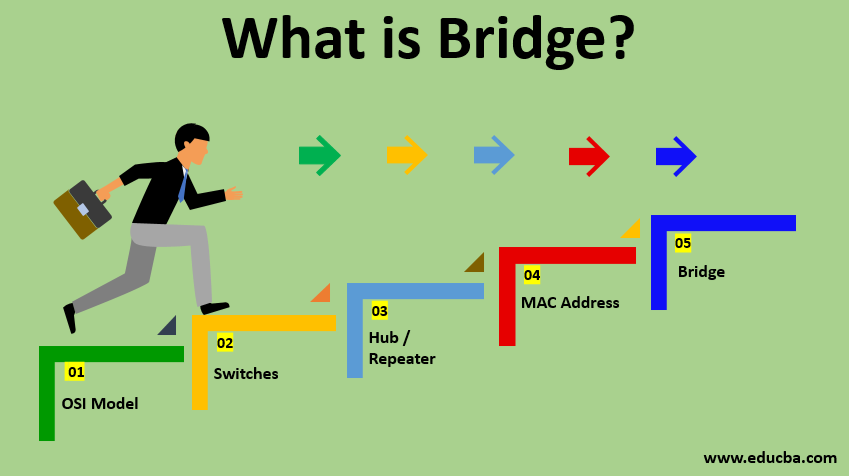Updated August 10, 2023
Introduction to Bridge
A computer networking device to create a single network from different computer networks or segments is called a network bridge. The same communication protocol is used to communicate and transfer packets between network segments. A bridge is operated in the data link layer of the open systems model. The network traffic is isolated and identified using Bridge. When the networks are not connected using a router, bridges help connect them and communicate. The network is divided into segments that are managed easily in the network. Bridges extend LAN and make it cover more area.
Terminologies
Here are the following Terminologies mention below
1. OSI Model
A conceptual model that enables the standardization of communication function. In this model, the entire communication system model is partitioned into abstraction layers. The layers are:
- Physical Layer
- Data Link layer
- Network Layer
- Transport Layer
- Session Layer
- Presentation Layer
- Application Layer
In layer 2 is where the bridge works in the communication channel.
2. Switches
The switch is networking hardware that enables connection in a computer network by using packet switching for receiving and forwarding data to the destination device. Packet switching is a methodology in which data is grouped into packets over the digital networks. Therefore, it helps in boosting of efficiency of Bridge.
3. Hub/Repeater
The repeater is a Layer 1 component of a network. Repeater helps in regenerating signals over the same network before the network goes weak or corrupted. And hub is basically a multiport repeater.
4. MAC address
MAC stands for Media Access C On a lighter note; MAC address is nowhere connected to Apple products. This address helps in the unique identification of a device in the network. It is very analogous to the fingerprint/retina of a person. No two fingerprints/retina will be the same, and the same is for MAC, i.e. no two MAC addresses are the same for different devices. Currently, the MAC address is two 6-digit hexadecimal numbers, separated by colons.
5. Bridge
As discussed above, It acts as a connection between two parts of a network at a data link layer of the OSI model. They are primarily used in local area networks because of their ability to broadcast data to all nodes, thus leading to clog and the flood of the network. The bridge’s working principle is very similar to switch, but the traffic is managed differently in bridge than switch. A Bridge is also a repeater working on layer 2 with the addon functionality of filtering MAC addresses.
When do we use the Bridge?
- Before we dive into when we use the bridge, let’s see how bridgework. A bridge, when it receives the signal from incoming network traffic, inspects that and then determines whether to forward or discard the traffic or signal according to its intended destination.
- For example, an ethernet bridge inspects each incoming Ethernet frame, including the source and destination MAC addresses. And then forwards the individual decision of what needs to be done with the signal. Bridge gas has a single input and a single output, thus making it a 2-port device. It is reliant on the database to ascertain the route of passing, transmitting or discarding a signal.
- With the data frame’s active involvement, if the frame received is for the segment that resides on the same host network, the frame will be passed to that node, and the bridge on the receiving end will then discard it. On the other hand, if the frame has a MAC address of the connected network, it will forward the signal/data.
- Now coming to on when we use a bridge. Though there are other network devices present, when do we use the bridge? In the next section, we would look into the advantages of the bridge, thus answering the question of why we use them.
When do we use the bridge?
- When packets of data are transferred without locating addresses.
- When we need to locate an unknown address to which it is viable to send a message.
- When remembering and recalling the addresses of devices for future transmission is required.
- Commonly used in token ring networks.
- When 2 LAN works on the same protocol.
Advantages of Bridge
- They are simple to use and relatively inexpensive.
- The data load is lowered over the data link layer.
- It can be made intelligent by effectively coding to reject any signal or packets from meticulous networks.
- They are translucent over the MAC layer.
- If the user wants to lower, the bandwidth utilization bridges come in very handy.
- It enables reducing the network traffic by subdividing the load through various communications.
- It helps in extending a network by acting as a repeater and also helps reduce collisions.
- Network bandwidth in an individual node is increased as fewer nodes share a collision domain.
Conclusion
- Though there are noticeable advantages of a bridge, no network device can be a perfect device. It has some noticeable disadvantages. It can’t identify the types of broadcast messages and is thus unable to filter them, thus leading to the transfer of all types of broadcast messages and unable to limit the transfer’s scope.
- It is more expensive than repeaters or hubs, but the extra cost is a trade-off of it being extra intelligent. Since filtering takes place in bridges, it is somewhat slower than repeaters or hubs. On the other hand, it helps in buffering data frames, and thus it affects performance. Though the disadvantages are not that noticeable looking at the advantages, It is an important networking device in today’s world, and it is used extensively!
Recommended Articles
This is a guide to What is Bridge?. Here we discuss the terminologies and advantages of Bridge along with why and when we use it?. You may also look at the following article to learn more –



